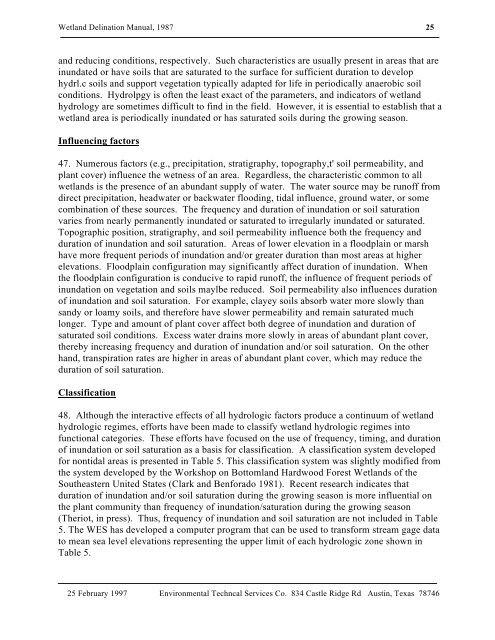1987 Wetland Delineation Manual - The Wetlands Regulation Center
1987 Wetland Delineation Manual - The Wetlands Regulation Center
1987 Wetland Delineation Manual - The Wetlands Regulation Center
Create successful ePaper yourself
Turn your PDF publications into a flip-book with our unique Google optimized e-Paper software.
<strong>Wetland</strong> Delination <strong>Manual</strong>, <strong>1987</strong> 25<br />
and reducing conditions, respectively. Such characteristics are usually present in areas that are<br />
inundated or have soils that are saturated to the surface for sufficient duration to develop<br />
hydrl.c soils and support vegetation typically adapted for life in periodically anaerobic soil<br />
conditions. Hydrolpgy is often the least exact of the parameters, and indicators of wetland<br />
hydrology are sometimes difficult to find in the field. However, it is essential to establish that a<br />
wetland area is periodically inundated or has saturated soils during the growing season.<br />
Influencing factors<br />
47. Numerous factors (e.g., precipitation, stratigraphy, topography,t' soil permeability, and<br />
plant cover) influence the wetness of an area. Regardless, the characteristic common to all<br />
wetlands is the presence of an abundant supply of water. <strong>The</strong> water source may be runoff from<br />
direct precipitation, headwater or backwater flooding, tidal influence, ground water, or some<br />
combination of these sources. <strong>The</strong> frequency and duration of inundation or soil saturation<br />
varies from nearly permanently inundated or saturated to irregularly inundated or saturated.<br />
Topographic position, stratigraphy, and soil permeability influence both the frequency and<br />
duration of inundation and soil saturation. Areas of lower elevation in a floodplain or marsh<br />
have more frequent periods of inundation and/or greater duration than most areas at higher<br />
elevations. Floodplain configuration may significantly affect duration of inundation. When<br />
the floodplain configuration is conducive to rapid runoff, the influence of frequent periods of<br />
inundation on vegetation and soils maylbe reduced. Soil permeability also influences duration<br />
of inundation and soil saturation. For example, clayey soils absorb water more slowly than<br />
sandy or loamy soils, and therefore have slower permeability and remain saturated much<br />
longer. Type and amount of plant cover affect both degree of inundation and duration of<br />
saturated soil conditions. Excess water drains more slowly in areas of abundant plant cover,<br />
thereby increasing frequency and duration of inundation and/or soil saturation. On the other<br />
hand, transpiration rates are higher in areas of abundant plant cover, which may reduce the<br />
duration of soil saturation.<br />
Classification<br />
48. Although the interactive effects of all hydrologic factors produce a continuum of wetland<br />
hydrologic regimes, efforts have been made to classify wetland hydrologic regimes into<br />
functional categories. <strong>The</strong>se efforts have focused on the use of frequency, timing, and duration<br />
of inundation or soil saturation as a basis for classification. A classification system developed<br />
for nontidal areas is presented in Table 5. This classification system was slightly modified from<br />
the system developed by the Workshop on Bottomland Hardwood Forest <strong>Wetland</strong>s of the<br />
Southeastern United States (Clark and Benforado 1981). Recent research indicates that<br />
duration of inundation and/or soil saturation during the growing season is more influential on<br />
the plant community than frequency of inundation/saturation during the growing season<br />
(<strong>The</strong>riot, in press). Thus, frequency of inundation and soil saturation are not included in Table<br />
5. <strong>The</strong> WES has developed a computer program that can be used to transform stream gage data<br />
to mean sea level elevations representing the upper limit of each hydrologic zone shown in<br />
Table 5.<br />
25 February 1997 Environmental Techncal Services Co. 834 Castle Ridge Rd Austin, Texas 78746


